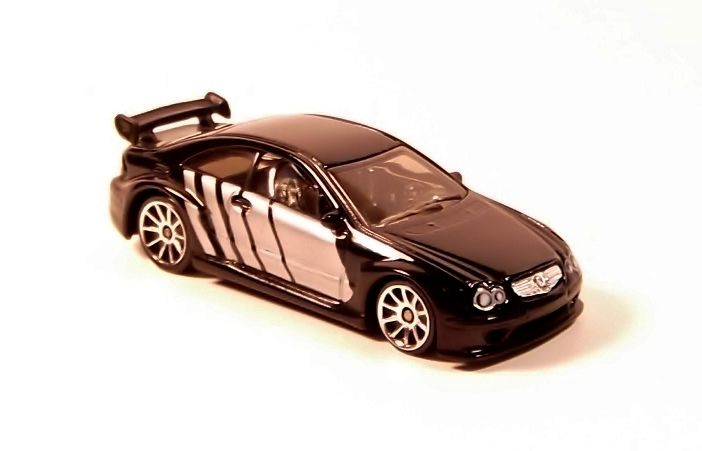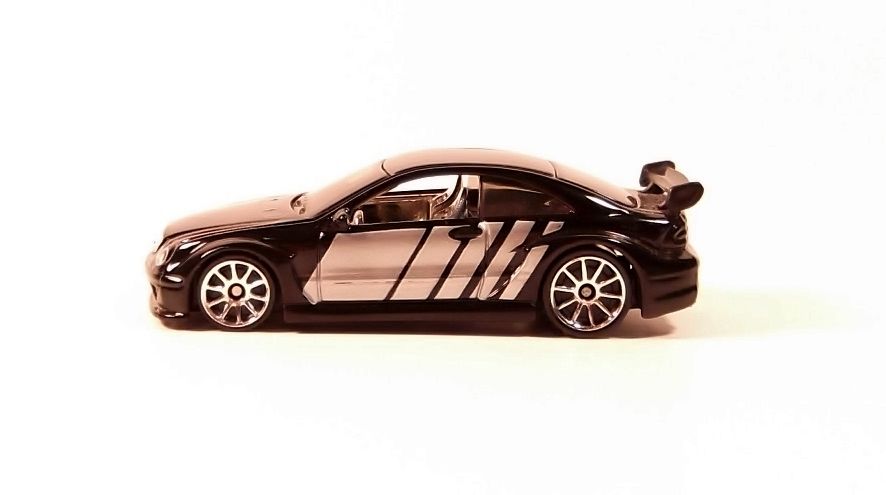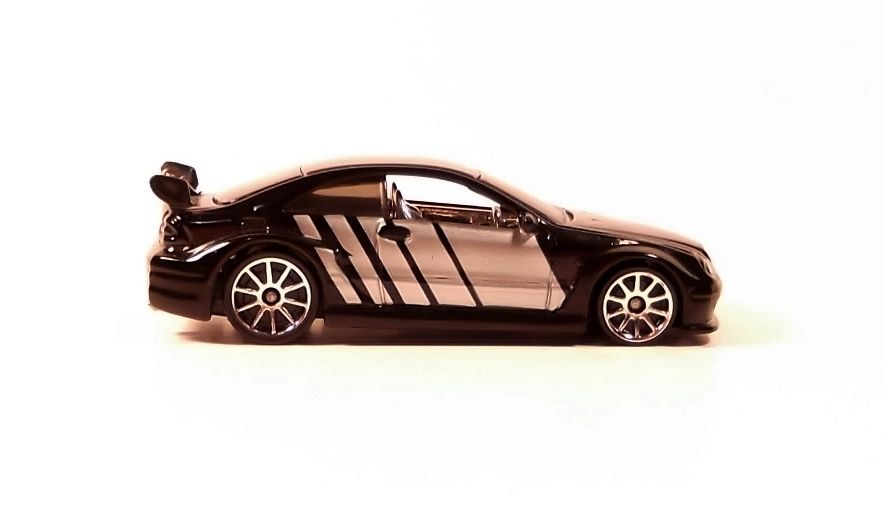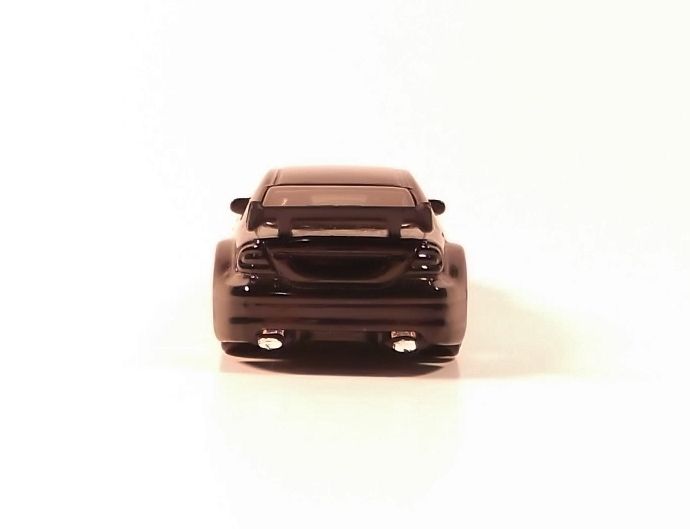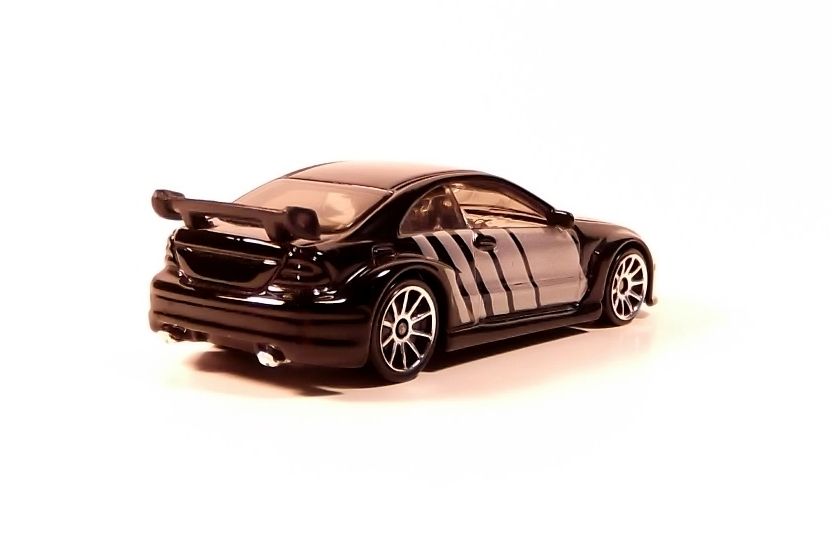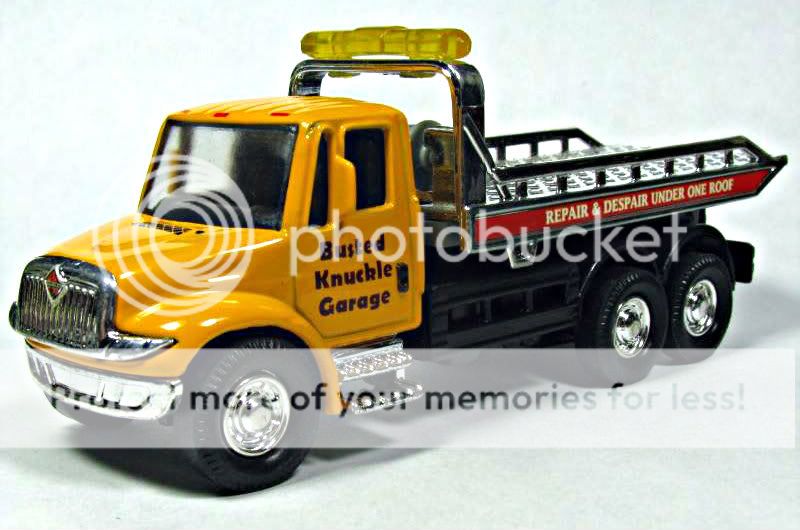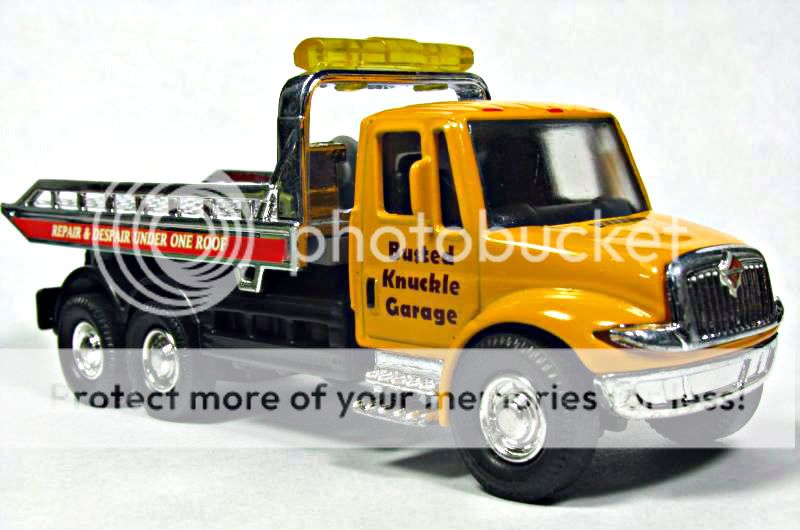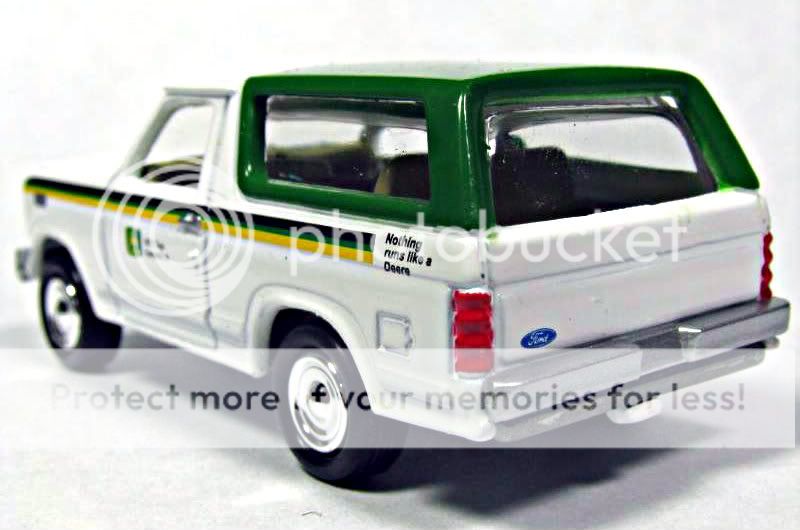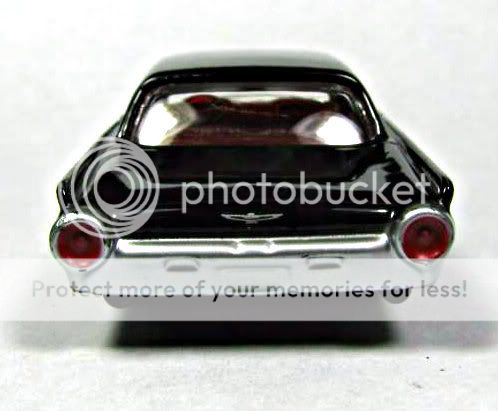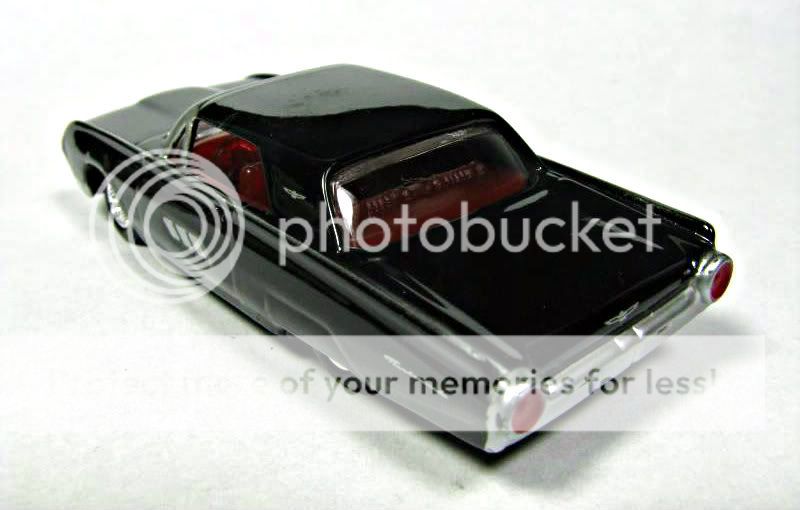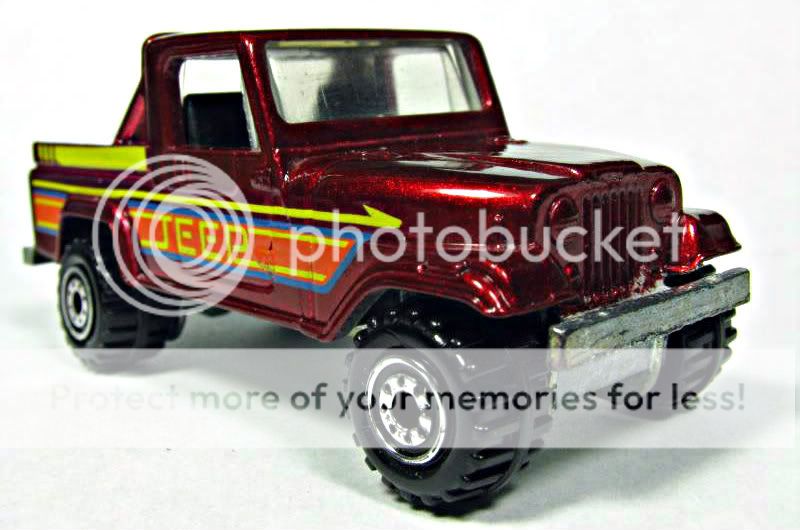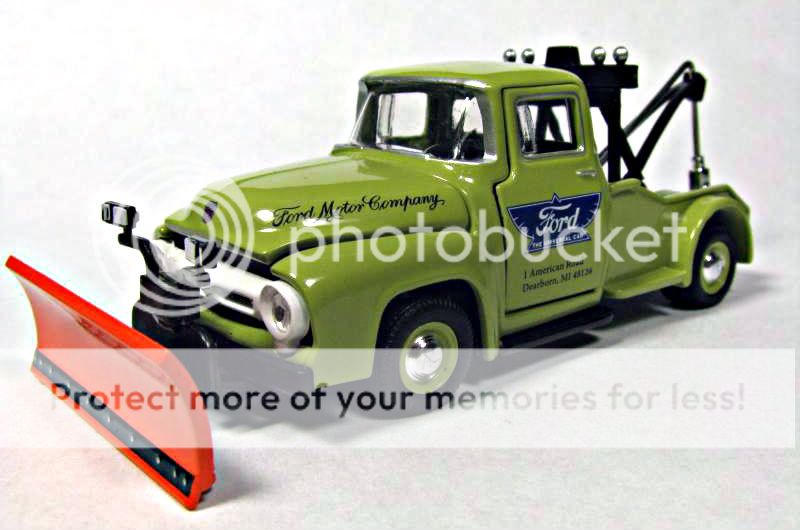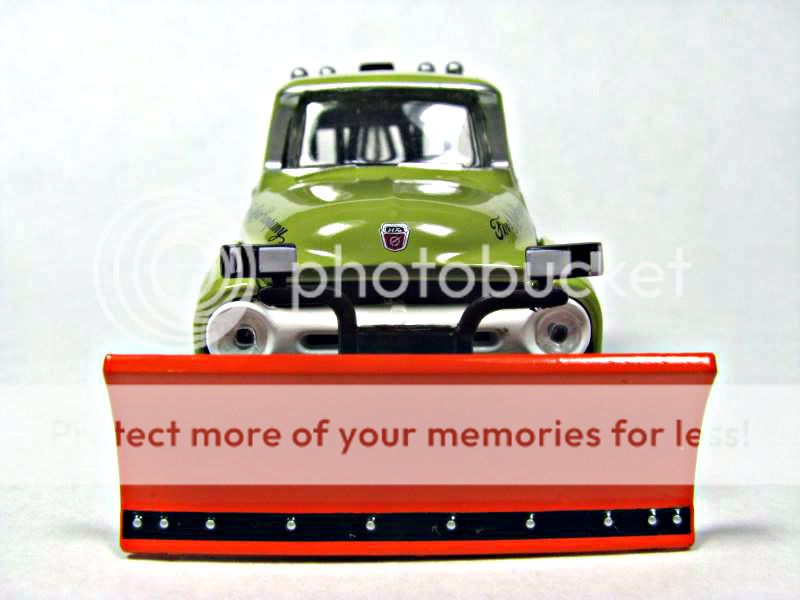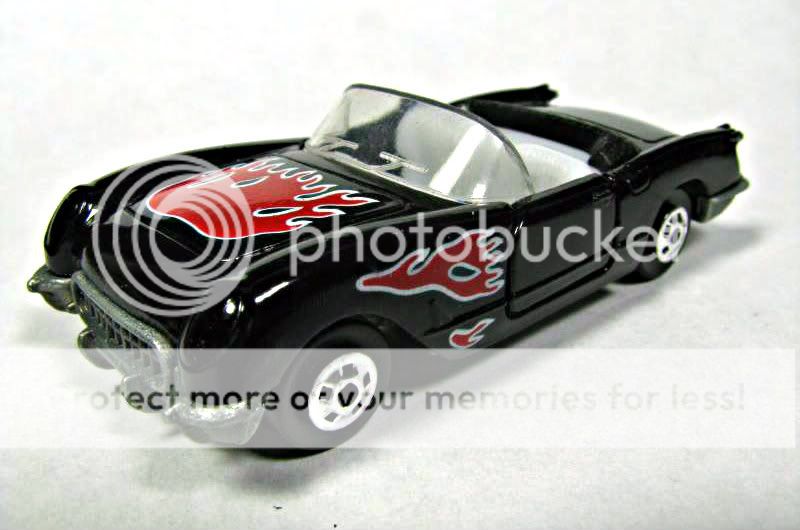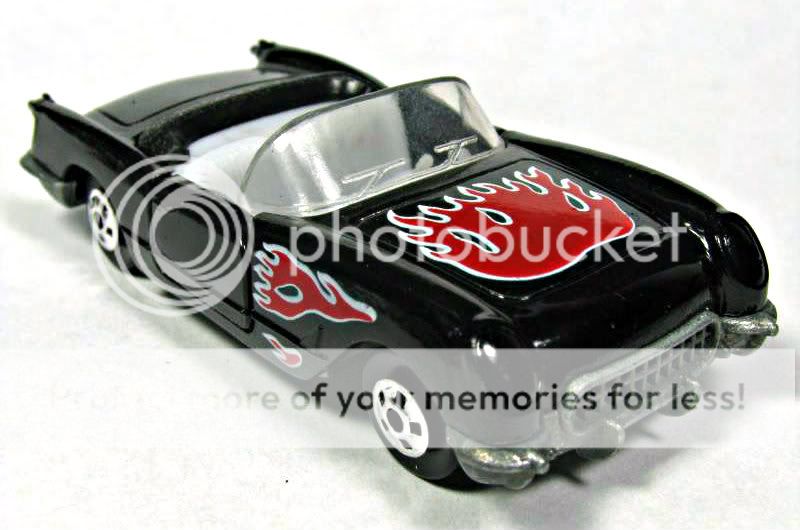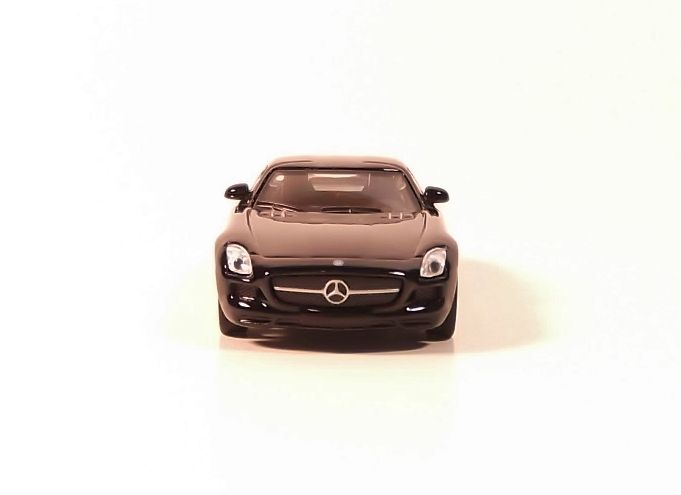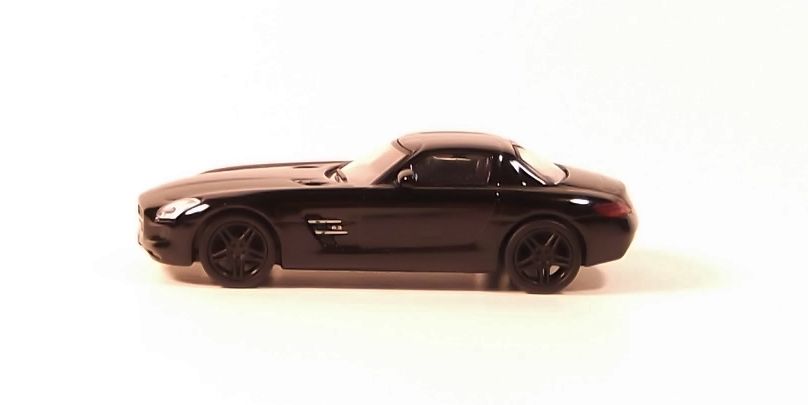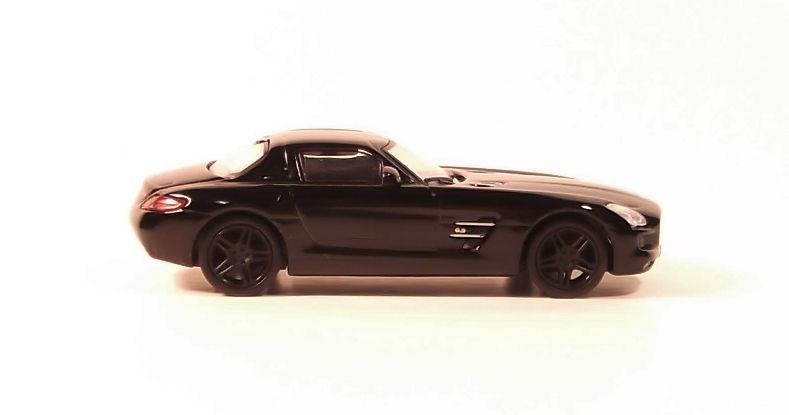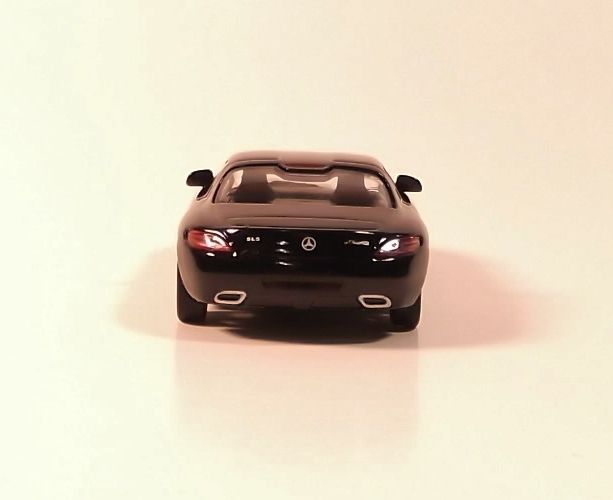
A blog focusing on 1/64 diecast from such popular brands as Hot Wheels, Matchbox, Johnny Lightning, M2 Machines, GreenLight, Tomica, Yat Ming, Majorette, MotorMax, Siku, Corgi, Guisval, Playart, Ertl, Zylmex, Racing Champions, & many more. Swifty's Garage features a daily Car Of The Day and news updates from your favorite brands!
Sunday, September 30, 2012
Car Of The Day: September 30, 2012
Today's car of the day comes from Firehawk73's collection and is Hot Wheels' 2006 Mercedes-Benz CLK-DTM.
The Mercedes-Benz CLK-Class is a mid-size rear-wheel drive coupé/convertible (Coupe Leicht Kurz or Coupe/Light/Short). While it was based on the W202 and W203 platforms of the C-Class, its styling cues, engine, and price range are closer to that of the E-Class, with Mercedes-Benz slotting the CLK as a coupé version of the W210 and W211 E-Class sedan/wagon. The CLK succeeded the W124 E-Class Coupe and it was in turn replaced by the C207 E-class Coupe.
For more information and pictures of the real car please visit: Mercedes-Benz CLK-DTM
The Mercedes-Benz C209/A209 cars have been produced since 2003. They are sold under the CLK-Class model names. The C209/A209 is based on the W203 C-Class. It replaced the C208 CLK-Class after 2003 which were the first car to carry the CLK moniker.
The C209/A209 is available in two body styles, a coupe (C209) and a cabriolet (A209), and is manufactured with diesel and petrol engines ranging from four-cylinder (CLK200) to eight-cylinder (CLK500 and CLK63AMG). The cabriolet (Designated with an A, as in CLK500A) features a fully automatic retractable soft top covered by a metal tonneau that can be raised and lowered from outside the vehicle using the key fob.
A CLK AMG DTM was produced as a MY2006 in both a coupe and later cabriolet model. Styling cues were taken from the C-Class race car used for the German Deutsche Tourenwagen Masters racing series. The car includes a wider body, rear wing spoiler, carbon fiber accents, and upgraded suspension.
Performance is electronically limited to 135 mph (217 km/h) in the CLK350 and CLK500 models, and to 155 mph (249 km/h) in the CLK55 model. An AMG factory option is available for an unrestricted top speed.
The Electronic Stability Control (ESP) and Anti-lock braking system (ABS) are both aids to handling, making such feats as a 90’ degree turn on a typical two lane intersection from 50 mph (80 km/h) possible using simple hard braking and turning with no significant fishtailing. The ESP system cannot be turned off - it makes intentional high-power fishtailing impossible without using a factory test protocol that end-users generally cannot enable.
Each model seats four and in the US this includes an all-leather interior with burl walnut trim. For Europe the models are available as "Elegance" and "Avantgarde" essentially, basically 'Luxury' or 'Attitude' specification where the Elegance uses Burr Walnut trim and polished alloy wheels and the Avantgarde uses alloy trim and chunkier wheels. Also there is the Sport upgrade package for the Avantgarde, with 18" Alloys and an interior upgrade. Finally there is also the "Sport" (UK only) - an 'AMG' version from factory for the 280 V6 petrol, 220 4 cyl diesel and the 320 V6 diesel (though not an AMG engine) trimmed (including 18" AMG alloys and wider rear track, suspension set-up, sport/tiptronic/manual gear options, body styling, paddle shifts, sports exhausts, etc.) and made available from 2005/06. The price and specification for European models is otherwise the same. The 4 cyl. cars wear 16" wheels, while the CLK320, CLK350 and CLK500 come with 17 inch (432 mm) alloy wheels, the CLK55 AMG sports 18" (457 mm). The cabriolets have a remote-operated automatic soft-top and sensor-controlled roll bars. Since its introduction, all US cars come standard with a Tele Aid emergency assistance system, automatic dual-zone air conditioning, 10-way power front seats and rain-sensing windshield wipers. Seven-channel digital surround sound comes standard. A Keyless Go system, navigation system, Parktronic system, and bi-xenon HID headlamps are all available as options. All models come with four side airbags. European cars differ considerably and are usually specced depending on the buyer's needs.
The cars have a manual sport/comfort mode switch that sets the automatic transmission to start in 2nd gear and shift earlier in comfort mode. With the new 7-speed transmission, the car is about 20% more fuel-efficient compared to the 5-speed, with no loss of performance. In the CLK500, at 80 mph (130 km/h), the 5-speed transmission runs at about 3000 rpm, while the 7-speed runs at about 2200 rpm. In the AMG model, the transmission can be set to remain longer in lower gears for higher performance.
The 5-speed CLK500 gets an average of 15mpg in city driving conditions, whereas the 7-speed CLK550 get an average of about 18mpg under the same conditions. Both add about 3mpg for highway driving.
The C209/A209 CLK-Class is 2.4 inches (61 mm) longer, 0.7 inches (18 mm) wider and 1.1 inch (28 mm) higher than its predecessor.
Saturday, September 29, 2012
Truck Of The Day: September 29, 2012
The truck for today is Shing Fat's International Durastar 4300.
The International DuraStar, originally introduced as the International 4000 Series, is a medium-duty truck produced by Navistar International. First produced in 2002, it is the successor to the 4000 Series of the 1990s.
It is available in three variants, which are built on the same chassis. They differ in engines, drivetrains, brakes, and cargo capacity. It is a popular commercial platform used in a wide variety of applications, such as emergency services, towing, flatbed truck and as a cargo box truck. Variants of the Durastar are commonly used as a platform for both school buses and commercial buses.
The 4300 model has a wheelbase from 128" to 254", is powered by an International DT466 and uses either hydraulic or air brakes. It comes with Fuller 6 or 7-speed manual transmissions or Allison 2000 and 3000 Series automatic transmissions. Its front axle capacity is 8000-14000 lb. Rear axle capacity is 12,200-23,000 lb.
I love International so obtaining a Duratstar flat bed was a must after Hosspower98 posted some pics of these. It's a bit larger than 1/64 scale as the length of the bed messes up the proportions a bit. It's a true working roll back and offers a pull motor.
Friday, September 28, 2012
SUV Of The Day: September 28, 2012
Johnny Lightning's 1980 Ford Bronco is the SUV for today.
The Ford Bronco is a sport utility vehicle that was produced from 1966 to 1996, with five distinct generations. Broncos can be divided into two categories: early Broncos (1966–77) and full-size Broncos (1978–96).
The Bronco was introduced in 1966 as a competitor to the small four-wheel-drive compact SUVs such as the Jeep CJ-5 and International Harvester Scout, and built on its own platform. A major redesign in 1978 moved the Bronco to a larger size, and it was built using a shortened Ford F-Series truck chassis to compete with the similarly adapted Chevrolet K5 Blazer.
The full-size Broncos and the successor Expedition were produced at Ford's Michigan Truck Plant in Wayne, Michigan.
The Bronco received a major redesign for 1980, coinciding with the F-Series. The new Bronco was shorter, and had cosmetic changes along with powertrain, suspension and other odds and ends. Most notably, the live front axle was replaced by a Dana 44 Twin Traction Beam (TTB) setup in the front end for an independent front suspension. The TTB is a hybrid of a true independent front suspension and a solid front axle, with a "solid" axle that pivots around the differential and uses coil springs instead of leaf springs. The TTB system offered a higher degree of control and comfort both on and off road, but sacrificed wheel travel, and is notorious for being difficult to keep aligned when larger than stock tires are used.
With a smaller Bronco and fuel economy in mind, Ford offered a 300 cu in (4.9 L) straight six as the base engine. Though this engine came with more torque than the 302 cu in (4.95 L) V8 and comparable to the 351 cu in (5.75 L) V8 (until the High Output model), it was limited by a 1-bbl carburetor and restrictive single-out exhaust manifolds. Electronic emissions equipment added in 1984 further reduced the power of the inline six. Ford used up their remaining stock of 351M engines before turning over to the 351W in mid-model year 1982. A "High Output" version of the 351W became an option in 1984 and continued well into the 1987 model year until the introduction of fuel injection. Output was 210 hp (157 kW) at 4000 rpm vs the standard 2-bbl 351W which made 156 hp (116 kW) at 4000 rpm. The 302 was the first engine to receive electronic fuel-injection, starting in the 1985 model year, as well as a four-speed automatic overdrive transmission. The Eddie Bauer trim package started in 1985 as well. From 1980 to 1984, some Broncos had sliding topper windows.
In 2011, JL released a John Deere themed mini set which included a '50 Olds, '93 F-150 plus this Bronco. Thus far this old Racing Champions casting has only been issued just this one time in the JL line.
Thursday, September 27, 2012
Car Of The Day: September 27, 2012
Today's car of the day comes from craftymore's collection and is High Speed's 1963 Ford Thunderbird.
The Thunderbird ("T-Bird"), is an automobile manufactured by the Ford Motor Company in the United States over eleven model generations from 1955 through 2005. When introduced, it created the market niche eventually known as the personal luxury car.
A new third-generation Thunderbird bowed for 1961 on an unchanged wheelbase and would see mostly minor alterations through 1963. Distinctive styling was highlighted by severely pointed front profiles, modest "blade" tail fins, big circular tail lamps (a sometimes Ford hallmark), and outward-curving body sides bereft of sheet metal sculpturing.
There was again just one engine: Ford Division's new 390 V-8, a stroked 352 but delivering the same 300 horsepower. An optional power package offered 40 more bhp for 1962-63. With minor alterations, the 390 would be the basic Thunderbird power plant through 1968, joined by big-block options beginning with '66. Base prices for '61 stood at $4172 for the hardtop and $4639 for the rag top.
Third-generation engineering was conservative but sound. Ford had contemplated front-wheel drive, but felt it too unorthodox for this market. Instead, engineers stressed quality control, solid construction, ride comfort, and minimum noise at speed. Extensive use of rubber bushings for the coil-spring independent front and leaf-spring rear suspensions made the 1961-63 Thunderbirds among the best-riding cars of the day.
Slightly less than a quarter of a million Thunderbirds rolled off the assembly lines of Ford for the '61-'63 3rd generation 'personal luxury' car. At this point, the Thunderbird was seen as a luxy Ford car that had similar looks of the larger Lincoln Continental evoking an elegance not seen in other Ford cars. High Speed produced this 1/64 item in the early 2000s and it remains the only true stock example in small scale of a '61-'63 Thunderbird hardtop.
After Greenlight bought the High Speed castings previously used in the Readers Digest series and other models, there had been speculation as to when or if we'd see the '63 Bird included in their Motor World line. With the High Speed factory closing in China this year, we found out GL did not obtain the mold for this casting which disappointed me greatly. Had hoped to see this in the Motor World line to buy a few for my collection plus one for custom duty . . . . aka derby bait! :D While that won't happen, I'm very glad to have this in my collection. I was lucky enough acquire this model from Hosspower98 who won a lot of High Speed items and offered several to me. :thumbup: This had been one of my grail items.
Wednesday, September 26, 2012
Truck Of The Day: September 26, 2012
Today's car of the day comes from craftymore's collection and is Hot Wheels' 1983 Jeep Scrambler CJ-8.
The Jeep CJ-8 was a long wheel-base version of the CJ-7, introduced in 1981. It featured a 103-inch (2,616 mm) wheelbase and a removable half-cab, creating a small pick-up style box instead of utilizing a separate pickup bed. Only 27,792 were built in the five years of production before being replaced by the similarly sized Comanche.
CJ-8s used the traditional transfer case and manual front-locking hubs to engage the four-wheel drive. Most had a four- or five-speed manual transmission, but a three-speed automatic transmission was an option.
Many CJ-8's were equipped with the "Scrambler" appearance package which included tape graphics and special wheels.
A full length steel hardtop CJ-8 was made for the Alaskan Postal Service, using right hand drive and automatic transmissions. Instead of the rear tailgate, the steel hardtop utilized a hinged barn door opening to the back. There were only 230 produced and sold in the U.S. It was also widely sold in Venezuela and Australia as the CJ8 Overlander, with small differences including full length rear windows on the Overlander. Steel hardtops used on these postal Scramblers and Overlanders were known as "World Cab" tops.
HWs sold more copies of the Scrambler than what Jeep has. They produced this issue in 1988. This was a recent purchase from Pegers.
Tuesday, September 25, 2012
Snowplow Of The Day: September 25, 2012
Today's truck is M2 Machines' 1956 Ford F-100.
The 1956 F-100 is a one-year only body style. The 1956 F-100 is easily identified as it has vertical windshield pillars and a wrap around windshield as opposed to the sloped pillars and angled windshield of the 1953-55. The 1956 model also offered a larger wraparound back window as an option. Starting in 1956, Ford offered the very rare "Low GVWR" versions of each model. Also in 1956, seat belts became an option.
The '56 F-100 was available with either the inline 223 cubic inch inline six which offered up 137 horsepower or the 272 cubic inch Y-Block V8 with 173 horsepower.
Check out Wikipedia to learn more on the '56 Ford.
No one is currently offering the amount of details for the price point that M2 currently is. A '56 Ford in small scale is cool enough with opening doors and all metal construction. Toss in a snow blade and tow accessories and ya got one sweet ride.
Sunday, September 23, 2012
Car Of The Day: September 23, 2012
Today's car of the day comes from craftymore's collection and is Road Champs' 1953 Chevrolet Corvette.
The Chevrolet Corvette is a sports car by the Chevrolet division of General Motors that has been produced in six generations. The first model, a convertible, was designed by Harley Earl and introduced at the GM Motorama in 1953 as a concept show car. Myron Scott is credited for naming the car after the type of small, maneuverable warship called corvette. Originally built in Flint, Michigan and St. Louis, Missouri, the Corvette is currently built in Bowling Green, Kentucky and is the official sports car of the Commonwealth of Kentucky. The National Corvette Museum documents the car's worldwide history and hosts the annual event.
The 1953 model year was not only the Corvette's first production year, but at 300 produced it was also the lowest-volume Corvette. The cars were essentially hand-built and techniques evolved during the production cycle, so that each 1953 Corvette is slightly different. All 1953 models had Polo White exteriors, red interiors, and black canvas soft tops. Order guides showed heaters and AM radios as optional, but all 1953 models were equipped with both. Over two-hundred 1953 Corvettes are known to exist today. They had independent front suspension. The cost of the first production model Corvettes in 1953 was $3490.
The quality of the fiberglass body as well as its fit and finish was lacking. Other problems, such as water leaks and doors that could open while the car was driven, were reported with the most severe errors corrected in subsequent units produced, but some shortcomings continued beyond the Corvette's inaugural year. By December 1953, Chevrolet had a newly equipped factory in St. Louis ready to build 10,000 Corvettes annually. However, negative customer reaction in 1953 and early 1954 models caused sales to plummet.
In 1954, only 3,640 of this model were built and nearly a third were unsold at year's end. New colors were available, but the six-cylinder engine and Powerglide automatic, the only engine and transmission available, were not what sports car enthusiasts expected. It is known that 1954 models were painted Pennant Blue, Sportsman Red, and Black, in addition to Polo White. All had red interiors except for those finished in Pennant Blue that had a beige interior. Order guides listed several options, but all options were "mandatory" and all 1954 Corvettes were equipped the same.
Road Champs first issued the '53 Vette in the early to mid 1980s. The version shown came in a 5 pack of 1950s convertibles. This '53 like the others in the set, all offered opening doors, metal bases and top up or top down plastic inserts.
Car Of The Day: September 22, 2012 (Belated)
Todays car of the day is a GreenLight Motorworld 2010 Mercedes Benz SLS AMG
The Mercedes-Benz SLS AMG is a luxury grand tourer automobile developed by Mercedes-AMG to replace the Mercedes-Benz SLR McLaren. The car is the first Mercedes automobile designed in-house by AMG and is described by Mercedes-Benz as a spiritual successor to the Mercedes-Benz 300SL Gullwing.
The vehicle was unveiled at the 2009 IAA. Sales began in mid-2010 in Europe with MSRP of €177,310 (including taxes) and in the United States in mid-2011 for less than $200,000.
For more information and pictures of the real car please visit: Mercedes-Benz SLS AMG
The SLS AMG was designed to be a modern 300SL Gullwing revival by Mark Fetherston in 2007. The car has a long bonnet, the passenger compartment is close to the rear axle and the rear of the car is short. The SLS AMG was developed from late 2006 in tandem with the Dodge Viper, with mules using Viper body panels over an aluminum chassis developed by Dodge SRT. The SLS AMG has also adapted the feature of wing doors that will swing open upwards on gas struts, not in a mix of upwards and forward like the SLR. The doors must be closed manually as AMG engineers decided against auto-closing systems because the systems would have added 90 pounds (41 kg) to the car. In case of a roll-over, the doors can be fully detached to allow the occupants to leave the vehicle.
Although there is some overlapping in price and performance, the lighter SLS AMG is considered more of a sporty track-oriented car, compared to the Mercedes-Benz SL which is a more autobahn-focused grand tourer especially with its optional V12 engine. Compared to the SLS AMG Roadster, the SL is a hardtop convertible with technological and comfort amenities, and it also has available heated and cooled seats with a massage function.
The SLS AMG will be made in at least four different versions. The first to launch is the coupe with gullwing doors. In 2009 a Desert Gold version debuted at the Dubai International Auto Show, in mid-2010 a FIA-GT3 racing version. For 2011–2013 Mercedes will also be releasing a roadster (with conventional doors and a soft top), an electric powered E-Cell version (most likely to be a coupe), and there will be a Black Series version, which will see its weight being reduced by as much as 300 kg (661 lb).
Subscribe to:
Posts (Atom)
